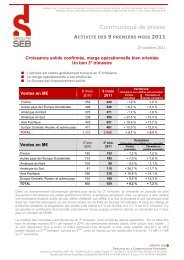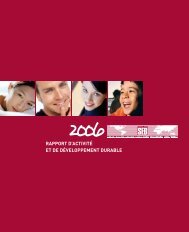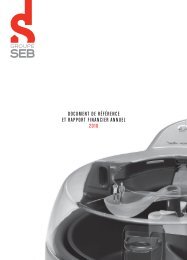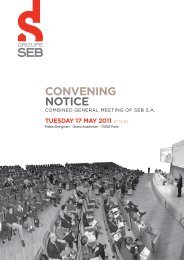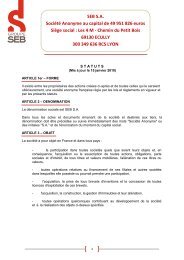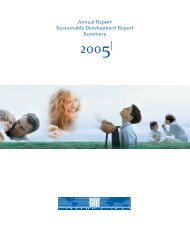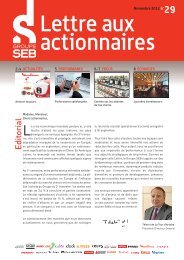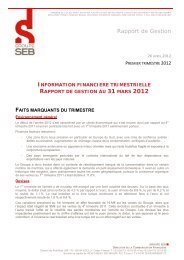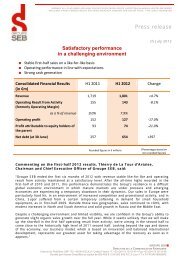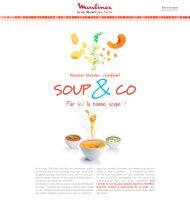financial report and registration document 2011 - Groupe SEB
financial report and registration document 2011 - Groupe SEB
financial report and registration document 2011 - Groupe SEB
Create successful ePaper yourself
Turn your PDF publications into a flip-book with our unique Google optimized e-Paper software.
INTEREST-RATE RISK AND CURRENCY RISK<br />
The Group sells its products in more than 150 countries. With a substantial<br />
proportion of our manufacturing still based in Europe (37% of products<br />
sold), the Group’s business is strongly export-oriented. Exchange rate swings<br />
thus affect our ability to be competitive, so that these must be effectively<br />
managed from a long-term perspective. To limit the direct impact of currency<br />
fl uctuations, <strong>Groupe</strong> <strong>SEB</strong> strives to balance incoming fl ows (products)<br />
<strong>and</strong> outgoing fl ows (expense) in each currency <strong>and</strong> especially in terms of<br />
procurement, by diversifying sources geographically. However, this cannot<br />
fully redress imbalances, as the Group’s dollar position is short-term, while<br />
for several other currencies it is long-term. To limit this risk, the Group also<br />
uses fi nancial instruments to hedge transaction risks.<br />
For several years, the Group’s trading activity has been strongly disrupted<br />
by volatile exchange rates. Given the swings between the sharp collapse<br />
of several currencies (rouble, Korean won, Turkish lira, Mexican peso, etc.)<br />
versus the euro in 2009, the rallying of these same currencies in 2010,<br />
followed by another round of depreciation in <strong>2011</strong>, the Group is constantly<br />
forced to adapt its pricing policy: increasing sale prices to preserve the<br />
local profi tability of commercial subsidiaries where the relevant currency<br />
depreciates against the euro <strong>and</strong> adjusting prices downwards to preserve<br />
market momentum <strong>and</strong> competitiveness where foreign currency/euro<br />
exchange rates improve. The effects on the Group’s turnover are therefore<br />
very different from one year to another. For example, exchange rate effects<br />
had a negative impact of €63 million on sales in 2009, while in 2010 they<br />
had a positive impact of +€170 million. In <strong>2011</strong>, they were again negative<br />
(-€26 million). The effects also impacted income albeit less dramatically.<br />
Group fi nancing uses mostly variable-rate loans in currencies that correspond<br />
to its needs (mainly the euro <strong>and</strong> the US dollar). Nevertheless, a portion of the<br />
Company’s debt – the longest-term extending to 2016 – has been fi nanced<br />
Sensitivity analysis<br />
<strong>Groupe</strong> <strong>SEB</strong> conducted a sensitivity analysis of data published in <strong>2011</strong> to<br />
assess the impact of euro-dollar exchange rate variations on its operating<br />
result from activity * <strong>and</strong> the effect of interest-rate variations on profit<br />
before tax.<br />
Concerning the euro-dollar exchange rate, as a regular buyer of dollars or<br />
in “dollar zones” (raw materials, products sourced in Asia, etc.), <strong>Groupe</strong><br />
<strong>SEB</strong> has held a “short-term” position in this currency for several years.<br />
The sensitivity analysis shows that a 1% variation in the euro-dollar exchange<br />
rate would have an impact of about €3 million on the Group’s operating<br />
result from activity (formerly known as the operating margin). However, other<br />
important operating currencies for the Group could also have a signifi cant<br />
impact on operating result from activity. These include the yen, the rouble,<br />
the pound sterling, the Turkish lira, the Korean won, the Polish zloty, the<br />
Brazilian real <strong>and</strong> the Mexican peso. The depreciation of important currencies<br />
for the Group can have a strong negative impact, such as in 2009, while<br />
their appreciation in relation to the euro can result in a very positive effect<br />
* Formerly operating margin.<br />
Financial Report <strong>and</strong> Registration Document <strong>2011</strong><br />
1<br />
Presentation of the Group<br />
Risk management<br />
at a fi xed rate, making it possible for the Group to protect itself against the<br />
likelihood of interest-rate rises.<br />
Details of interest rate <strong>and</strong> exchange rate risks are given in Notes 26.2.1<br />
<strong>and</strong> 26.2.2 to the Consolidated Financial Statements.<br />
RISKS RELATING TO SHARES<br />
At 31 December <strong>2011</strong>, <strong>Groupe</strong> <strong>SEB</strong> held 2,331,797 treasury shares for a total<br />
value of €93.2 million. This treasury stock is deducted from shareholders’<br />
equity at acquisition cost.<br />
On the basis of the closing price of the <strong>SEB</strong> share at 31 December <strong>2011</strong> (€58.12),<br />
the market value of treasury stock was €135.5 million (this market value has<br />
no impact on the Group’s consolidated fi nancial statements). A 10% increase<br />
or decrease in the share price would therefore have led to a €13.6 million<br />
change in the fair value of treasury stock. This variation has no impact on<br />
the consolidated income statement or shareholders’ equity.<br />
After two years of very strong stock market growth in 2009 <strong>and</strong> 2010 (at<br />
+85% in 2009 <strong>and</strong> +96% in 2010), <strong>SEB</strong>’s stock experienced a more diffi cult<br />
year in <strong>2011</strong>, underperforming the indices throughout almost the entire<br />
year. In late December, however, the share price essentially recovered to<br />
its original level. This fl uctuation, in a complicated, bleak macroeconomic<br />
environment <strong>and</strong> in an, essentially, bear market, appears to be the result of<br />
profi t-taking given the unrealised gains available to investors. In the end,<br />
after greatly outperforming the market for two years, <strong>SEB</strong>’s share price fell<br />
by 26% over <strong>2011</strong>, while the CAC 40 index was down 19% <strong>and</strong> the CAC<br />
Mid 60 was down 22%.<br />
Further information on share risks is given in Note 26.2.4 to the Consolidated<br />
Financial Statements. This data also takes account of risk on the Supor share<br />
which is quoted on the Shenzhen stock market.<br />
(as it was the case in 2010). At any rate, the fi nal impact is the result of all<br />
fl uctuations in the rates between the euro <strong>and</strong> other currencies, which may<br />
vary greatly from one currency to another. These fl uctuations may partially<br />
offset one another, cancel each other out, combine for an even greater<br />
impact, etc. In <strong>2011</strong>, because the average euro-dollar exchange rate was<br />
less than it was in 2010 (average euro-to-dollar rate of 1.39 in <strong>2011</strong> vs. 1.33<br />
in 2010), the Group was at an advantage in its procurement, <strong>and</strong> this positive<br />
exchange rate effect on operating result from activity * more than offset the<br />
negative impact of other currencies.<br />
This sensitivity analysis does not take into account the impact of currency<br />
exchange fl uctuations on the competitive capacity of our European industrial<br />
facilities, which still represent a large share of the Group’s production: a<br />
strong euro in relation to most other currencies, notably the US dollar,<br />
makes European manufacturing more expensive than production in dollar<br />
zones, <strong>and</strong> thus acts as a curb on exports. Inversely, a stronger dollar<br />
could be a source of better competitiveness for our European production<br />
GROUPE <strong>SEB</strong><br />
1<br />
17



